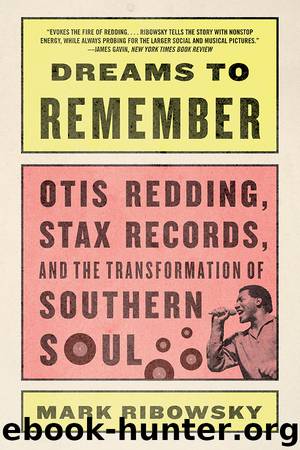Dreams to Remember by Mark Ribowsky

Author:Mark Ribowsky
Language: eng
Format: epub
Publisher: Liveright
Published: 2015-03-16T04:00:00+00:00
14
“The Only Son-of-a-Gun This Side of the Sun”
Otis was rapidly nearing hallowed ground by the beginning of 1967. In that year, the New York Times’ Robert Shelton would write in retrospect that Redding was as polished a performer as any in the rock gentry, and was “comparable, perhaps, to the life-is-sad-but-bearable moods of Frank Sinatra . . . what might be described as ‘an ecstasy singer,’ finding both joy and pain ecstatic and communicable emotions.”1 So, too, was he capable of self-mockery, a component that made his songwriting wonderfully engaging.
On a broad arc, Otis had accomplished more than he could have been aware of at the time. One of the better repercussions of the now fully fledged soul genre was that singers like Otis Redding, Wilson Pickett, Sam and Dave, Marvin Gaye, Stevie Wonder, and the Temptations need not step aside for white acts covering their songs, usually badly but also with more market success. Those days were, mercifully, over. The crossover appeal of these acts was carved on the singularity of their respective niches; simply, their songs could not be attempted without acute embarrassment, excluding when a Stax hand redid a Motown song (witness Redding’s cover of “My Girl”). And now, apropos of Redding’s “Satisfaction,” soul acts could cover rock and roll standards with impunity, with a whole new groove, and were valuable even if few of these works matched the sales level of the original.
White or “blue-eyed” soul acts—the term having been semi-seriously coined by black Philadelphia DJ Georgie Woods in the early ’60s, and more cynically adopted by music journalists in the British press apropos acts such as Tom Jones and even the Beatles and Rolling Stones—were of course free to create a similar groove. Some, including the Righteous Brothers, Rascals, the Soul Survivors, and the Box Tops, even did so admirably, frequently aided by producers like Tom Dowd and Muscle Shoals’ Rodney Mills and Jimmy Johnson. Then again, by the mid-sixties most rock songs were in some form an inculcation of the soul groove. However, the old rule still applied, only now as stone cold reality: When something new, and salient, was heard in pop music, it came from the soul stew, and if it was appropriated by the white rockers, it was almost always inferior.
Knowing this was a tremendous impetus for men like Otis Redding, who was practically knighted when he crossed the ocean. Otis, to his credit, now had a worldly view, quite more layered and empowering than when he was still in Macon, and an insouciance that other soul singers simply did not have. Alex Hodges attests to the fact that “around sixty-six, sixty-seven Otis really grew. He was still the country boy but he could walk into a chandeliered room filled with guys in Guy Laroche tuxes and women in Yves Saint-Laurent gowns, wearing his cardigan and casual slacks, and regale them, always know what to say. Women who hadn’t smiled in years were almost swooning like schoolgirls.”2 Redding was compatible with
Download
This site does not store any files on its server. We only index and link to content provided by other sites. Please contact the content providers to delete copyright contents if any and email us, we'll remove relevant links or contents immediately.
Cecilia; Or, Memoirs of an Heiress — Volume 3 by Fanny Burney(31034)
Cecilia; Or, Memoirs of an Heiress — Volume 2 by Fanny Burney(30981)
Fanny Burney by Claire Harman(25820)
We're Going to Need More Wine by Gabrielle Union(18123)
Plagued by Fire by Paul Hendrickson(16667)
Cat's cradle by Kurt Vonnegut(13952)
Bombshells: Glamour Girls of a Lifetime by Sullivan Steve(13156)
All the Missing Girls by Megan Miranda(12832)
Leonardo da Vinci by Walter Isaacson(11968)
4 3 2 1: A Novel by Paul Auster(11115)
Adultolescence by Gabbie Hanna(8173)
The remains of the day by Kazuo Ishiguro(7623)
Note to Self by Connor Franta(7051)
Diary of a Player by Brad Paisley(6888)
Giovanni's Room by James Baldwin(5966)
What Does This Button Do? by Bruce Dickinson(5564)
Recovery by Russell Brand(4597)
Born a Crime by Trevor Noah(4560)
The Kite Runner by Khaled Hosseini(4525)
